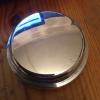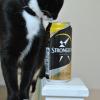
Piston Ring Gap And Oil Consumption
#16

Posted 22 February 2016 - 08:44 PM
#17

Posted 22 February 2016 - 08:47 PM
Attached Files
#18

Posted 22 February 2016 - 08:57 PM
18cc is a very big dish volume. Maybe a piston with a smaller dish, but a head with larger combustion chambers and skim a bit off the top of the pistons to lower the CR a bit. Only a full calculation will show whether this is possible. I believe a piston with an 11cc dish is available in +040, but it is a few years since I built a forced induction engine at +040. From memory I used a piston with an 11cc dish and an enlarged combustion chamber increased by around 4 cc. Don't have the calculation sheets to hand now.
#19

Posted 22 February 2016 - 09:03 PM
I've got about 0.010-0.011" at the pin line.
#20

Posted 22 February 2016 - 09:36 PM
I spoke to MED today and they said I should have 0.002-0.003 clearance at bottom of bore?
I'd agree with MED.
0.008 bottom of bore to skirt of piston
0.025 top piston ring gap at mid bore
Sorry, I missed that in your earlier post.
0.008" Piston to Bore Clearance - I think that's your problem right there.
Also you mention valve guides, these are often reamed instead of the correct method of honing, reaming will give you more "clearance" than honing so more leakage.
Actually, IMO, both methods, Honing and Reaming are correct. Reaming is perfectly normal and accepted practice, however Honing does generally give a better result, though more time consuming, therefore usually more expensive, hence why it's not always done. It's also not always the best long term way to go either. Bronze Guides respond better to Honing than Iron.
For 99% of the road going 'stuff' out there, Reaming is quite OK, however for top end 'stuff' and when looking for every 0.1% advantage the Honing may be the way to go. Horses for courses really.
One potential issue thought with Honing guides is that they may hold no oil what so ever, which will lead to more rapid initial wear of the Guide and Stem than with Reamed Guides, which will always hold some Oil, which will aid with Guide-to-Stem Sealing.
Yes of course, because everyone reams their blocks to fit pistons !!! lol reaming guides is a bodge,
Can you add your proof ? as it is a fact well known within the industry that honing retains oil .... think engine block !
Honing retains oil, reaming does not !
Honing is much more accurate so has better valve cooling properties than reaming.
Reaming valve guides is nothing more than a bodge in after market applications.
In production, reaming is done to under size guides because the correct amount of material is then removed, after market guides are already to size and reaming takes them oversize.
OK, a few things here.
What happens and is needed between Cylinder Bores and Valve Guides are quite different, so processes involved are not comparable.
Please, I'll respectfully ask that you not refer to Reaming as a 'bodge'. It is not. As I posted earlier, it's Horses for Courses.
As soon as I get my Office PC up and running again, I'll scan and post up some info from the Horse's mouth on Reaming of Guides.
However, in the interim, if you have access to a copy of ACL's Engine manual, have a read of page 149, I'll scan it when I can and post it here for everyone's benefit.
Also, Goodson's are a Company who specialise in Engine Reconditioning equipment, they have an extensive range of Reamers for Valve Guides;-
https://www.goodson.com/Reamers/
For what ever it's worth, there's also some info in Wiki;-
https://en.wikipedia...iki/Valve_guide
Admittedly, this company has a product to sell, however, they are very popular none the less (and would only be so for a reason);-
http://catalog.zodia...RS/Product.aspx
In Particular, the say;-
"You will ream a valve guide to exact dimension without any taper in 4 to 5 seconds only. Guides will last longer than with the honing method because there is no crosshatch left after reaming. One size allows you to fit both intake & exhaust if you use AV&V valves & guides. Note: These reamers are for Manganese bronze only, do not use with cast iron guides."
Which does raise an issue with Honing. Honing is very good, however it is only very good if done perfectly correctly and thoroughly cleaned afterwards otherwise it can be your worst nightmare. Barrelling or Hour Glassing are common issues, especially with small bores, like Guides. If they are not cleaned properly after Honing, they'll wear the Valve Stems away in no time.
This is not to knock the process of Honing at all, but highlight a few of the problems that it can bring about of not done correctly.
I'll also add that I've been Reaming most guides for over 30 years and can't say I've ever had an issue from it. I have also Honed a few, but these have been for special applications. I can't speak for most or every shop who does head work, but I'm sure a large number of them also Ream their Guides. if if were an issue, they wouldn't do it as they simply have come backs, which no commercial operation would want.
Give me a few days and I'll post up some scanned info.
#21

Posted 22 February 2016 - 11:36 PM
I spoke to MED today and they said I should have 0.002-0.003 clearance at bottom of bore?
I'd agree with MED.
0.008 bottom of bore to skirt of piston
0.025 top piston ring gap at mid bore
Sorry, I missed that in your earlier post.
0.008" Piston to Bore Clearance - I think that's your problem right there.
Also you mention valve guides, these are often reamed instead of the correct method of honing, reaming will give you more "clearance" than honing so more leakage.
Actually, IMO, both methods, Honing and Reaming are correct. Reaming is perfectly normal and accepted practice, however Honing does generally give a better result, though more time consuming, therefore usually more expensive, hence why it's not always done. It's also not always the best long term way to go either. Bronze Guides respond better to Honing than Iron.
For 99% of the road going 'stuff' out there, Reaming is quite OK, however for top end 'stuff' and when looking for every 0.1% advantage the Honing may be the way to go. Horses for courses really.
One potential issue thought with Honing guides is that they may hold no oil what so ever, which will lead to more rapid initial wear of the Guide and Stem than with Reamed Guides, which will always hold some Oil, which will aid with Guide-to-Stem Sealing.
Yes of course, because everyone reams their blocks to fit pistons !!! lol reaming guides is a bodge,
Can you add your proof ? as it is a fact well known within the industry that honing retains oil .... think engine block !
Honing retains oil, reaming does not !
Honing is much more accurate so has better valve cooling properties than reaming.
Reaming valve guides is nothing more than a bodge in after market applications.
In production, reaming is done to under size guides because the correct amount of material is then removed, after market guides are already to size and reaming takes them oversize.
OK, a few things here.
What happens and is needed between Cylinder Bores and Valve Guides are quite different, so processes involved are not comparable.
Please, I'll respectfully ask that you not refer to Reaming as a 'bodge'. It is not. As I posted earlier, it's Horses for Courses.
As soon as I get my Office PC up and running again, I'll scan and post up some info from the Horse's mouth on Reaming of Guides.
However, in the interim, if you have access to a copy of ACL's Engine manual, have a read of page 149, I'll scan it when I can and post it here for everyone's benefit.
Also, Goodson's are a Company who specialise in Engine Reconditioning equipment, they have an extensive range of Reamers for Valve Guides;-
https://www.goodson.com/Reamers/
For what ever it's worth, there's also some info in Wiki;-
https://en.wikipedia...iki/Valve_guide
Admittedly, this company has a product to sell, however, they are very popular none the less (and would only be so for a reason);-
http://catalog.zodia...RS/Product.aspx
In Particular, the say;-
"You will ream a valve guide to exact dimension without any taper in 4 to 5 seconds only. Guides will last longer than with the honing method because there is no crosshatch left after reaming. One size allows you to fit both intake & exhaust if you use AV&V valves & guides. Note: These reamers are for Manganese bronze only, do not use with cast iron guides."
Which does raise an issue with Honing. Honing is very good, however it is only very good if done perfectly correctly and thoroughly cleaned afterwards otherwise it can be your worst nightmare. Barrelling or Hour Glassing are common issues, especially with small bores, like Guides. If they are not cleaned properly after Honing, they'll wear the Valve Stems away in no time.
This is not to knock the process of Honing at all, but highlight a few of the problems that it can bring about of not done correctly.
I'll also add that I've been Reaming most guides for over 30 years and can't say I've ever had an issue from it. I have also Honed a few, but these have been for special applications. I can't speak for most or every shop who does head work, but I'm sure a large number of them also Ream their Guides. if if were an issue, they wouldn't do it as they simply have come backs, which no commercial operation would want.
Give me a few days and I'll post up some scanned info.
You are taking my post well out of context....
1) off the shelf guides for the classic Mini are made to size, a reamer requires there to be a certain amount of material left i the bore for the reamer to cut otherwise it "dances" around and you get a poor finish not suitable for application.
If you have been reaming guides for 30 years then you will also know that they require a certain amount of material to work.
2) The cross hatch effect of honing actually retains oil it is why all F1 teams hone their guides.
3) Honing only leaves a taper in inexperienced hands, hence why they are selling reamers not expensive honing tools.
4) For off the shelf guides that are already to size it is a bodge, however most people appear to do it, is why so many issues do actually occur, smokey engines etc... I have measured valve head end float of 1mm+ on almost new heads.
What you are saying is that reaming is acceptable if done correctly ? which is where the issues lie, unless valve guides are purposely made undersize it will never be as good as it should be... try using the correct reamer size on an already to size guide and then use a larger reamer and see the difference.
I know that some production engines use reamers on guides, however they are made undersize so you get a half decent finish..
Honing is a much more accurate choice, a hone will give you a much truer hole than a reamer ever will, horses for courses you say but that is simply another way of saying "it's only a mini engine"
#22

Posted 23 February 2016 - 12:08 AM
"A picture speaks a thousand words"
The bore looks like it was honed with a glaze buster, I think I can see some scores and the pistons are showing signs of scuff.... the bore clearance is measured across the widest point of the oval pistons.... yes pistons are in the main oval, the skirt is the part that fits the bore as it doesn't get so hot and therefore has less to expand than the crown that sees the most heat, so not only are new pistons oval they are also tapered....
Edited by MRA, 23 February 2016 - 12:08 AM.
#23

Posted 23 February 2016 - 02:24 AM
You are taking my post well out of context....
Apologies here if I am, however, in all sincerity I thought I was well in context, and I find your post here confusing.
My comments were in reply to yours in regards to Reaming being a bodge method.
Respectfully, comparing to what's done at the very top echelon cutting edge of racing (F1) to street cars I feel is somewhat out of context.
I felt I had addressed you items list in 1) to 4) above.
Any job can be messed up, whether it be Honing, Reaming or mowing the lawn, I think we all agree on that, however Honing I will say is a fairly higher skilled operation and we working with smaller components is considerably harder to check that would be the case with Reaming.
I am not nor have I knocked Honing here.
But
Please, Reaming is not a bodge.
#24

Posted 23 February 2016 - 02:45 AM
You are taking my post well out of context....
Apologies here if I am, however, in all sincerity I thought I was well in context, and I find your post here confusing.
My comments were in reply to yours in regards to Reaming being a bodge method.
Respectfully, comparing to what's done at the very top echelon cutting edge of racing (F1) to street cars I feel is somewhat out of context.
I felt I had addressed you items list in 1) to 4) above.
Any job can be messed up, whether it be Honing, Reaming or mowing the lawn, I think we all agree on that, however Honing I will say is a fairly higher skilled operation and we working with smaller components is considerably harder to check that would be the case with Reaming.
I am not nor have I knocked Honing here.
But
Please, Reaming is not a bodge.
I machine holes on a daily basis using various methods, I will even resort to a gas torch if required, however my normal methods are as follows...
1) Drill, rapid removal of metal and initial hole making
2) milling cutters, circular intepolation ideal for making holes larger for instance to fit the head of a cap head screw...
3) reaming, yes I use reamers, I own over 3000, different reamers ideal to remove the last "finishing cut" for various jobs.
4) burnishing rolls highly accurate excellent surface finish no good for guides but good for high precision location, down to a few microns with mirror finish.
5) honing excellent roundness and surface finish, the best for valve guides.
You see I am not anti reaming, I do believe that reaming has it's place in Engineering, but not for aftermarket guides that are already to size, it is not the correct tool for the job, that said reamers are great, I even have the last box of reamers made to ream the taper pin holes in the top and bottom arms of the Mini.
What is needed is for after market guides to be left under size, maybe I will have to make a batch,,,
#25

Posted 23 February 2016 - 06:45 AM
"2) The cross hatch effect of honing actually retains oil it is why all F1 teams hone their guides."
So unless we're doing 15k rpm for hours we're good? ;) ( please don't take this too serious)
Edited by Dusky, 23 February 2016 - 08:06 AM.
#26

Posted 23 February 2016 - 07:45 AM
Mods, the start of another out of control posting.
#27

Posted 23 February 2016 - 09:19 AM
"2) The cross hatch effect of honing actually retains oil it is why all F1 teams hone their guides."
So unless we're doing 15k rpm for hours we're good? ;) ( please don't take this too serious)
Only 15k ? .... yeah stop going off topic...... ![]()
Edited by MRA, 23 February 2016 - 09:29 AM.
#28

Posted 23 February 2016 - 09:32 AM
Is this anything to do with the OPs original question, or has it turned into a bit of one upmanship?
Can we keep things on topic please?
#29

Posted 23 February 2016 - 10:17 AM
18cc is a very big dish volume. Maybe a piston with a smaller dish, but a head with larger combustion chambers and skim a bit off the top of the pistons to lower the CR a bit. Only a full calculation will show whether this is possible. I believe a piston with an 11cc dish is available in +040, but it is a few years since I built a forced induction engine at +040. From memory I used a piston with an 11cc dish and an enlarged combustion chamber increased by around 4 cc. Don't have the calculation sheets to hand now.
You wouldn't get the extra 7cc out of a head made for forced induction it is why the 18cc pistons where made Peter.
Unless the OP fitted a fairly mild cylinder head in which case a swap around of "CC's" may work.
#30

Posted 23 February 2016 - 10:21 AM
Is this anything to do with the OPs original question, or has it turned into a bit of one upmanship?
Can we keep things on topic please?
It is pertinent, because the OP was losing oil, and that could be down to valve guides as much as bore wear.
1 user(s) are reading this topic
0 members, 1 guests, 0 anonymous users



















